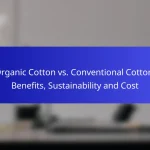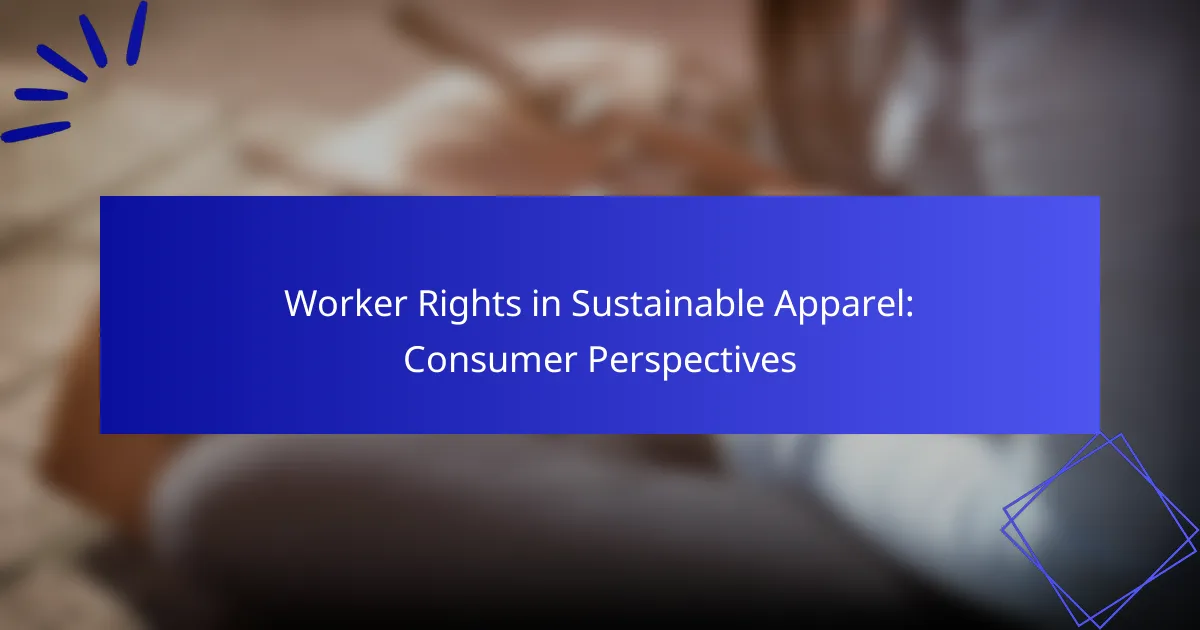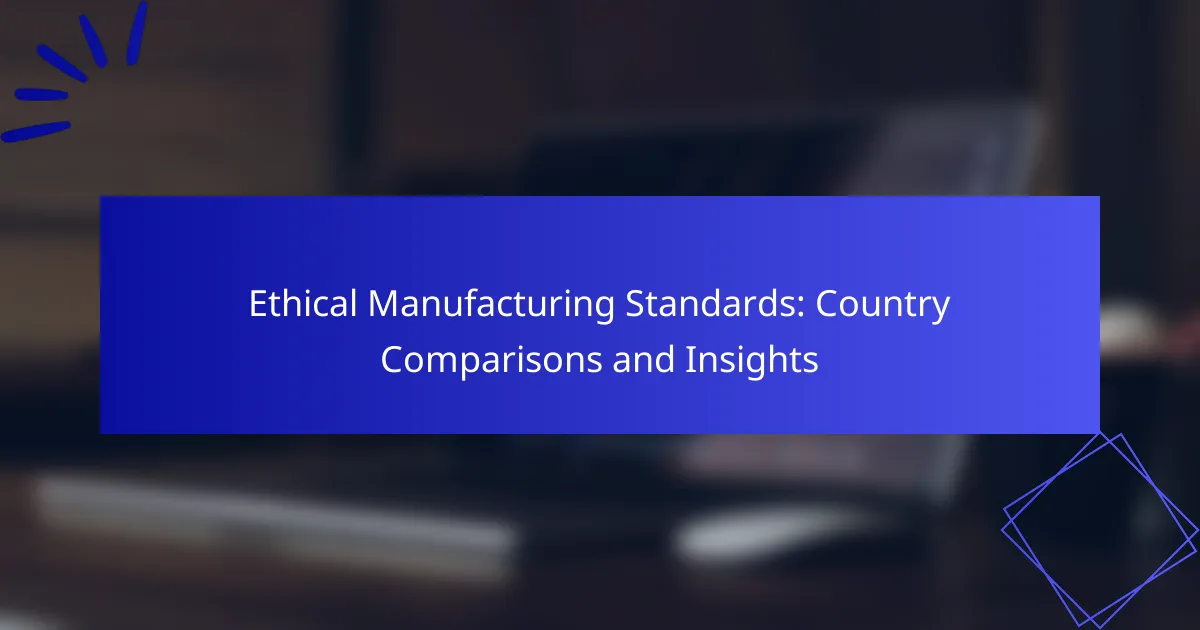Transparency in clothing manufacturing offers consumers valuable insights into the production processes, materials, and labor conditions behind their garments. By understanding these aspects, shoppers can make informed choices that reflect their values regarding quality and ethics, ultimately fostering trust in the brands they support.
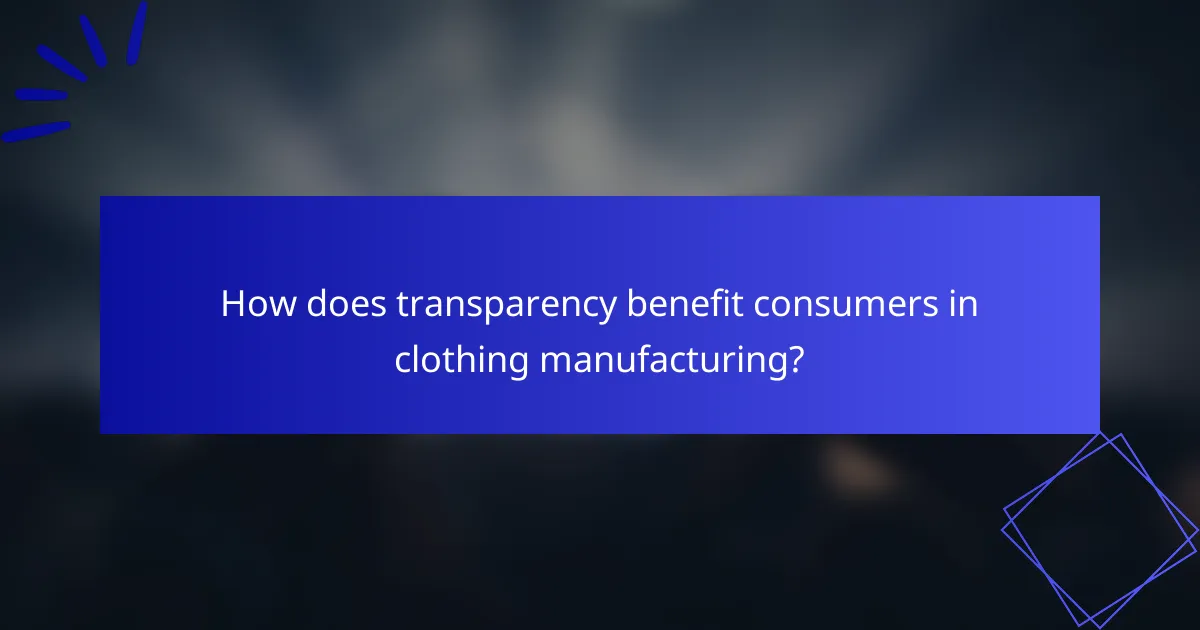
How does transparency benefit consumers in clothing manufacturing?
Transparency in clothing manufacturing benefits consumers by providing insight into the production processes, materials used, and labor conditions. This awareness empowers consumers to make better choices that align with their values and expectations regarding quality and ethics.
Enhanced product quality
When manufacturers are transparent about their processes, consumers can better assess the quality of the clothing they purchase. Knowing the sourcing of materials and the methods of production allows buyers to choose items made with high-quality fabrics and craftsmanship.
For example, a brand that openly shares its supply chain details may indicate the use of sustainable materials and ethical labor practices. This information can lead consumers to prefer products that are more durable and environmentally friendly.
Informed purchasing decisions
Transparency equips consumers with the knowledge needed to make informed purchasing decisions. By understanding the origins and production methods of clothing, buyers can evaluate whether a product meets their personal standards for sustainability and ethics.
For instance, consumers can compare brands based on their environmental impact or labor practices, allowing them to support companies that align with their values. This informed approach can help avoid purchases that may contribute to unethical practices in the fashion industry.
Increased brand trust
Brands that prioritize transparency often build stronger trust with their consumers. When companies openly share information about their manufacturing processes, it demonstrates accountability and a commitment to ethical practices.
As trust grows, consumers are more likely to remain loyal to brands that are honest about their operations. This loyalty can translate into repeat purchases and positive word-of-mouth, further enhancing the brand’s reputation in a competitive market.
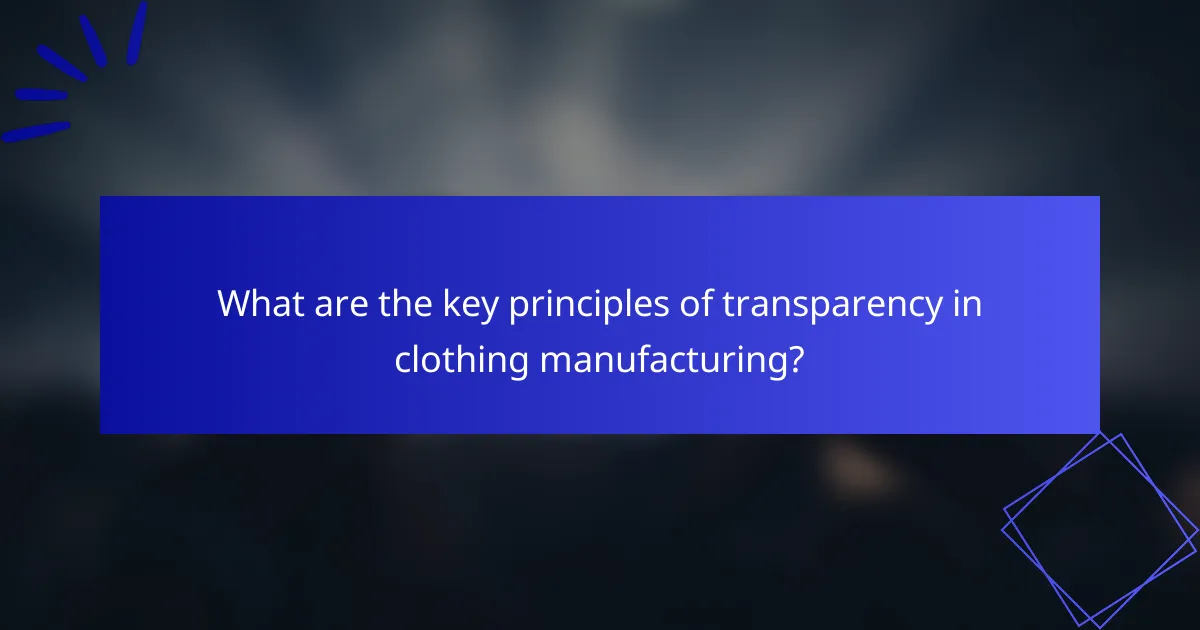
What are the key principles of transparency in clothing manufacturing?
Transparency in clothing manufacturing involves clear communication about the processes, materials, and labor practices involved in producing garments. Key principles include supply chain visibility and ethical labor practices, both of which empower consumers to make informed purchasing decisions.
Supply chain visibility
Supply chain visibility refers to the ability to track and understand the entire journey of a garment from raw materials to the finished product. This includes knowing where materials are sourced, how they are processed, and the logistics involved in their transportation. Brands that prioritize supply chain transparency often provide detailed information on their websites, allowing consumers to see the origins of their clothing.
To enhance supply chain visibility, companies can implement technologies like blockchain, which securely records every transaction in the supply chain. This not only builds trust with consumers but also helps brands identify inefficiencies and areas for improvement.
Ethical labor practices
Ethical labor practices ensure that workers involved in clothing manufacturing are treated fairly and work in safe conditions. This includes providing fair wages, reasonable working hours, and the right to organize. Brands that commit to ethical labor practices often undergo third-party audits to verify compliance with labor standards.
Consumers can support ethical labor practices by choosing brands that are certified by recognized organizations, such as Fair Trade or the Ethical Trading Initiative. These certifications indicate that the brand adheres to strict labor standards and is committed to improving the lives of workers in the supply chain.

Which brands exemplify transparency in clothing manufacturing?
Brands that exemplify transparency in clothing manufacturing openly share information about their sourcing, production processes, and labor practices. This commitment helps consumers make informed choices and fosters trust in the brand.
Patagonia
Patagonia is renowned for its transparency, providing detailed information about its supply chain and environmental impact. The company publishes an annual Environmental and Social Initiatives report, which outlines its efforts to reduce carbon emissions and improve labor conditions.
Additionally, Patagonia encourages customers to repair and recycle their clothing through initiatives like the Worn Wear program. This not only promotes sustainability but also reflects the brand’s commitment to responsible manufacturing practices.
Everlane
Everlane is committed to “radical transparency,” showcasing the true costs behind its products. The brand openly shares pricing breakdowns, including materials, labor, and transportation costs, allowing consumers to understand what they are paying for.
Everlane also provides information about its factories, including their locations and ethical standards. This approach helps consumers feel more connected to the products they purchase, knowing they support fair labor practices.
Reformation
Reformation focuses on sustainable fashion and transparency by offering detailed insights into its manufacturing processes. The brand’s website features a “RefScale” that quantifies the environmental impact of each item, helping consumers make eco-friendly choices.
Reformation also emphasizes ethical labor practices, ensuring that workers are paid fair wages and work in safe conditions. By prioritizing transparency, the brand builds trust with its customers and promotes a more sustainable fashion industry.

How can consumers identify transparent clothing brands?
Consumers can identify transparent clothing brands by looking for specific indicators such as certification labels and engaging brand storytelling. These elements provide insight into the brand’s manufacturing practices and commitment to ethical standards.
Certification labels
Certification labels are crucial for identifying transparent clothing brands. Look for well-known certifications like GOTS (Global Organic Textile Standard) or Fair Trade, which indicate adherence to specific environmental and social criteria. Brands displaying these labels typically undergo regular audits to ensure compliance.
When evaluating certification labels, consider the scope of the certification. Some labels focus on organic materials, while others emphasize fair labor practices. Understanding what each label represents can help consumers make informed choices.
Brand storytelling
Brand storytelling is another effective way to gauge transparency in clothing brands. Companies that share detailed narratives about their sourcing, production processes, and labor practices often demonstrate a commitment to ethical manufacturing. Look for brands that openly discuss their supply chain and the people involved in creating their products.
Engaging with a brand’s story can reveal its values and mission. Brands that prioritize transparency often provide behind-the-scenes content, such as videos or blog posts, showcasing their factories and workers. This openness can enhance consumer trust and loyalty.
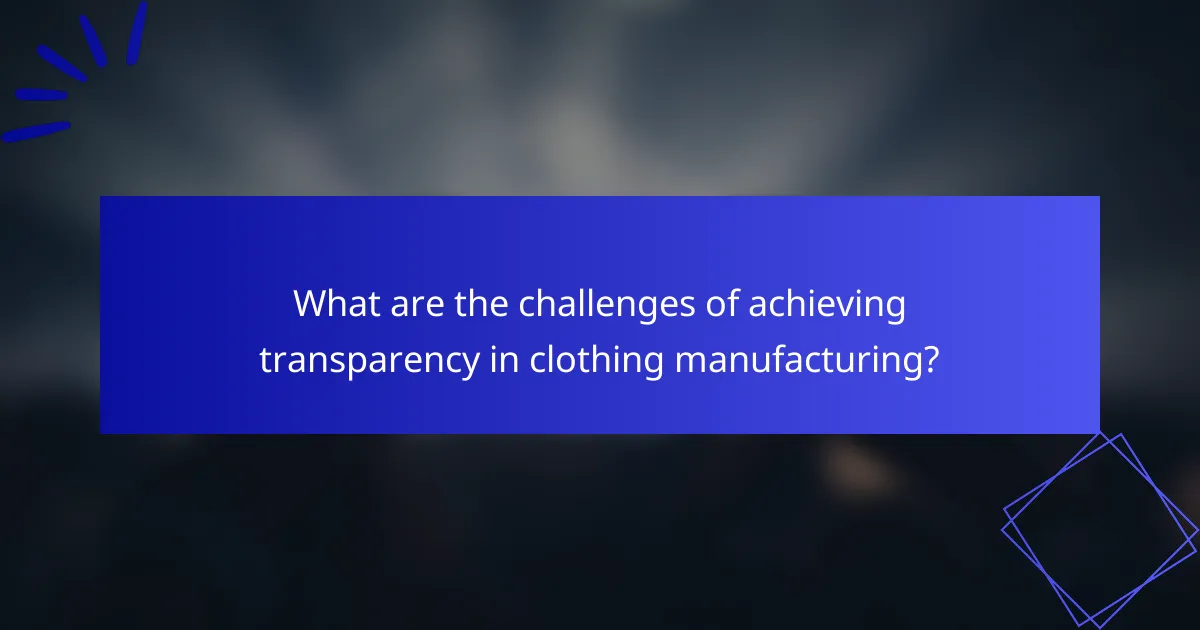
What are the challenges of achieving transparency in clothing manufacturing?
Achieving transparency in clothing manufacturing is difficult due to various factors, including complex supply chains and cost implications. These challenges can hinder consumers’ ability to understand the origins and production processes of their garments.
Complex supply chains
Clothing manufacturing often involves multiple stages and numerous suppliers, making it hard to trace the journey of a single item. Each step, from raw material sourcing to production and distribution, may involve different companies, each with its own practices and standards.
For example, a simple t-shirt may pass through cotton farmers, textile mills, dye houses, and factories before reaching the consumer. This complexity can obscure information about labor conditions, environmental impact, and ethical practices, leaving consumers in the dark.
Cost implications
Implementing transparency measures can increase operational costs for manufacturers, which may be passed on to consumers. Brands may need to invest in tracking technologies, audits, and certifications to ensure compliance with transparency standards.
For instance, while some companies may choose to disclose their supply chain information, the associated costs can lead to higher retail prices. Consumers should be aware that greater transparency might come with a premium, but it can also foster more ethical purchasing decisions.
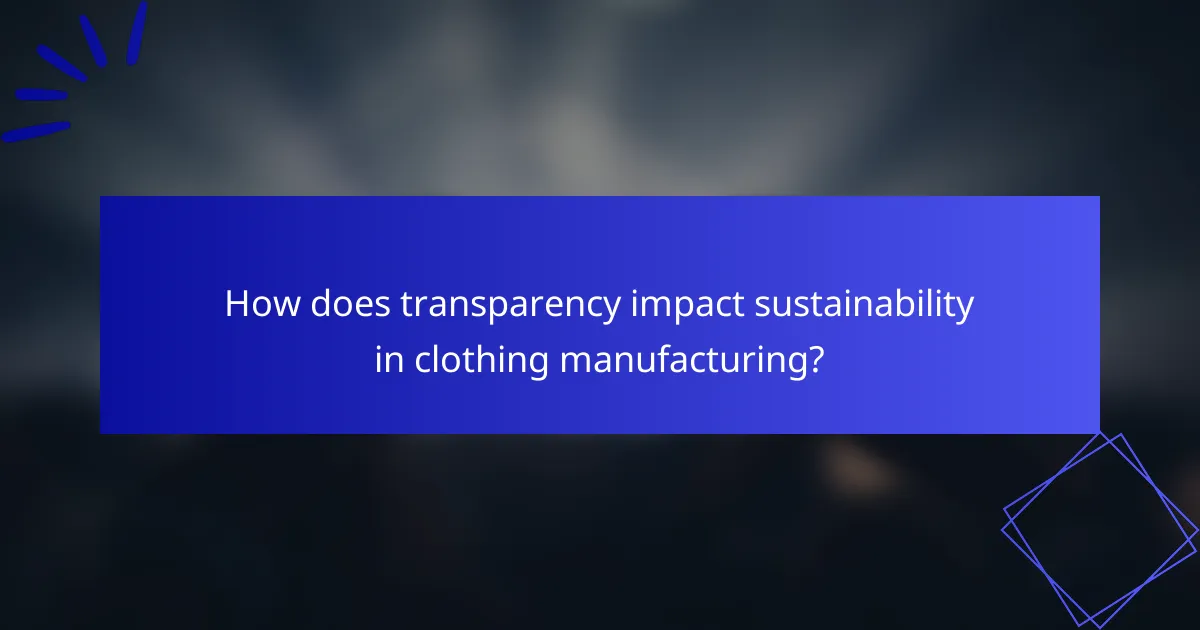
How does transparency impact sustainability in clothing manufacturing?
Transparency in clothing manufacturing significantly enhances sustainability by allowing consumers to understand the environmental and social practices of brands. This awareness encourages responsible consumption and promotes ethical practices within the industry.
Reduced waste
Transparency helps reduce waste in clothing manufacturing by enabling brands to share their production processes and inventory management practices. When consumers know how products are made and where they come from, they can make informed choices that favor brands with efficient practices.
For example, brands that disclose their overproduction rates can encourage consumers to buy only what they need, ultimately minimizing excess inventory. This approach not only conserves resources but also reduces landfill contributions.
Responsible sourcing
Responsible sourcing is a key aspect of transparency that ensures materials are obtained ethically and sustainably. Brands that openly share their sourcing practices can build trust with consumers who prioritize environmental and social responsibility.
For instance, companies that use organic cotton or recycled materials often highlight these choices, appealing to eco-conscious shoppers. By supporting brands that practice responsible sourcing, consumers can contribute to a more sustainable clothing industry.

What role do consumers play in promoting transparency?
Consumers play a crucial role in promoting transparency in clothing manufacturing by demanding clear information about the origins and production processes of their garments. By making informed choices and supporting brands that prioritize ethical practices, consumers can drive change in the industry.
Demanding accountability
Consumers can demand accountability from clothing manufacturers by actively seeking information about their supply chains and labor practices. This can include asking brands about their sourcing, production methods, and the treatment of workers involved in the manufacturing process.
One effective way to hold companies accountable is through social media and public forums. By sharing experiences and raising awareness about brands that lack transparency, consumers can influence others and encourage companies to adopt more ethical practices.
Additionally, consumers can support organizations and initiatives that promote transparency in the fashion industry. This can involve participating in campaigns, signing petitions, or choosing to shop from brands that are committed to ethical manufacturing standards.



